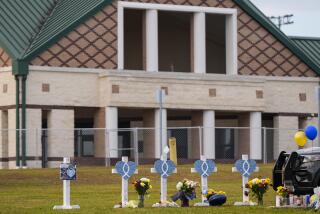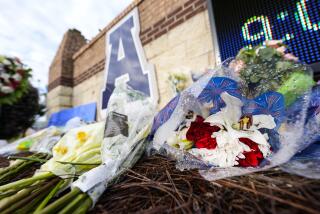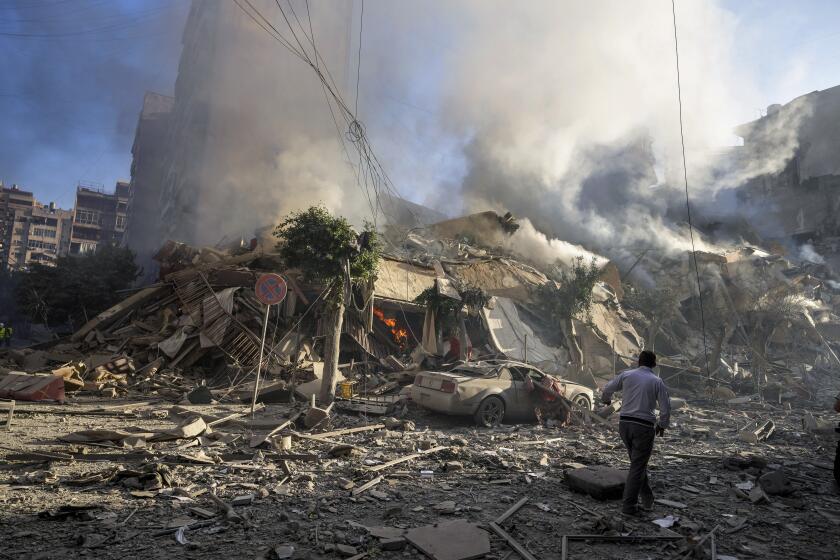Schools Learn to Take Threats More Seriously
After the killings, the children recalled the things that were said.
In each of four deadly schoolyard shootings that have shocked the nation since October, they said there had been talk of guns, revenge, hatred and death. The kinds of things a kid could easily dismiss coming from the mouth of another kid.
As a result, students and teachers alike are confronting the reality that sometimes students do make good on their threats. And in school districts across the country, administrators are beginning to rethink the way they respond to verbal threats.
“There’s a lot of discussion right now after this whole series of events,” said Marleen Wong, director of mental health services and district crisis teams for the Los Angeles Unified School District. “There are probably situations like this all over the country, where school districts are taking threats of this nature more seriously.”
That was the case at Macon County Junior High School in Tennessee last month when a teacher found a note titled “Death List,” containing the names of 15 students. School officials notified local police, who investigated and turned up a second list of 77 additional names.
A girl and a boy, both 13, have been suspended from school and face charges of harassment.
“With what has happened in Jonesboro and some of these other places, we don’t take any threat lightly,” said Jerry Wheeley, school superintendent for Macon County, referring to the March 24 shooting in Arkansas that took five lives.
That sentiment is strong in Arkansas, where the Jonesboro shootings have left teachers and administrators intensely alert to any signs of trouble among students--and quick to hand down serious punishment for words as well as deeds.
In the Jonesboro School District, near the Westside School District where the killings occurred, administrators acted swiftly after a boy shouted, “I’m gonna kill you!” into the ear of a schoolmate.
“Of course he didn’t mean that literally,” said Supt. Bill Beasley. “But he had to spend some time with counseling, so that he will remember that if something bothers him there are better ways of reacting.
“We just don’t tolerate [threats]. We confront them no matter how insignificant it might seem to the person who made or received it,” Beasley said.
Just how a threat should be handled is often a matter of state law and district policy. Even before the recent spate of shootings, some school districts had policies on how to respond to talk of violence.
Teachers and administrators in Los Angeles are required to report any indication or knowledge of a student’s plan to commit a felony, said Wayne Iwahashi, administrator of the L.A. Unified’s Student Discipline Proceedings Unit.
Yet anybody who works with students knows that bogus statements, tasteless jokes and bravado are as much a part of campus life as teachers and homework. The issue is not the laws or policies, but how stringently they are applied.
“If a threat is made, you have to separate the smoke from the fire,” Iwahashi said.
“Sometimes kids will joke, especially in middle school. The question is, is it a real threat? That issue is a difficult one.”
In a middle school near Pittsburgh, two seventh-grade boys were suspended for 10 days last month for their roles in distributing a list containing the names of 10 teachers that students purportedly wanted killed.
The school superintendent, William Pettigrew, would not discuss the specifics of the case, but said the boys “are very good students and very young men.”
“In this case they made a mistake,” Pettigrew said. “They claim it was a joke, kidding around. They picked a very inappropriate time to do that kind of thing.”
In retrospect, the statements and observations made before the four recent shootings seem clearly harsh and foreboding, obvious red flags that should have alerted even a teenager:
* Students in Edinboro, Pa., reportedly said 14-year-old Andrew Wurst showed a group of students a handgun in his father’s dresser drawer and told them he planned to kill nine people he hated and then kill himself. Students said the statements were made about a month before Wurst, nicknamed “Satan,” allegedly opened fire during an eighth-grade dance last week, killing a science teacher.
* In Jonesboro, Ark., 13-year-old Mitchell Johnson allegedly told other students he “had some killing to do.” Johnson and 11-year-old Andrew Golden are accused of killing four middle school girls and a teacher who had filed into the schoolyard after a false fire alarm.
* In West Paducah, Ky., students said 14-year-old Michael Carneal warned that “something big’s going to happen,” a week before he allegedly opened fire on a student prayer group, killing three students and wounding five last December.
* A neighbor of accused killer Luke Woodham testified that he watched the 16-year-old and an alleged conspirator, Grant Boyette, 18, chase the family dog and bludgeon the animal to death. Five months later, in October 1997, Woodham allegedly butchered his mother, then opened fire at his school in Pearl, Miss., killing two classmates and wounding seven others. Friends of Boyette--the alleged mastermind of the killings--later said he was fascinated by Satanism, obsessed with Adolf Hitler and studied violent philosophies.
Experts say the reaction of students to the comments made before these slayings was not uncommon for children their age. In counseling sessions after a student dies in a suicide or gang-related killing, counselors often discover that friends knew of trouble, but kept quiet out of loyalty or confusion.
“They didn’t want to tell anybody because they didn’t want to take it seriously,” said Keith Funk, a counselor at Westchester High School who has worked in education since 1973. “Or they didn’t want to get him or her in trouble, or they thought they could handle it themselves.”
One way to address the problem of verbal threats might be to respond with the same urgency that the Los Angeles school district requires when there is a threat of suicide, said Iwahashi.
By state law, teachers and others must report the problem to a third party, usually a parent, and assist families in finding mental health services for the child, said Richard Lieberman, psychologist with L.A. Unified’s Suicide Prevention Unit.
The district’s procedure is to also conduct a risk assessment, offer the child support through the school’s crisis team members and follow up with students and families. The suicide prevention unit runs a hotline to answer staff questions about how to handle suicidal students.
Suicide threats are “taken very, very seriously,” Iwahashi said. “That might just be the mode of operation we’re going to have to adopt in the future, but that’s still up for consideration.”
Spotting a student who is in trouble is a matter of paying close attention, not only to what is said, but also to how students behave, said Wong, head of Mental Health Services for L.A. Unified. Loud, outwardly aggressively students often attract attention from teachers--a classic case of the squeaky wheel getting the grease.
But being quiet and following the rules are not always signs that all is well with a child. Teachers should also look for changes in behavior, attendance problems, and deteriorating personal relationships. Children who are intensely withdrawn and who view themselves as outcasts may also need help.
“We need to start paying attention to those kids too, because they internalize things,” Wong said.
Public school counselors are equipped with the skills needed to identify such youth, but often spend more time in other functions, handling tardiness sweeps and administering tests, Funk said.
“Not enough of us who have counseling credentials are spending enough time watching for these signs,” he said.
Yet the value of intervention can be immense, even if the student has no plans of carrying out a threat.
Just days after the shooting in Jonesboro, a teacher at Palisades Senior High School in Pacific Palisades heard an angry ninth-grader talking about students who had been teasing him.
The boy said he could get a gun from his cousin and take care of his tormentors.
That teacher immediately notified the school psychologist, who called for a conference with the boy’s parents.
There was no such cousin and no gun, but a group of students had indeed been teasing the boy. Because the teacher decided to act, the boy found a solution to a very real problem, said Bella McGowan, school psychologist.
“I think we’ve all learned to err on the side of taking what a student says very seriously,” McGowan said.
Offering students an alternative method of resolving conflicts and a place to be heard can lessen the potential for violence, said McGowan and others. Peer counseling programs, campus crisis teams and mental health services can provide ways to help potentially volatile youth.
The new reality facing schools, urban and small-town alike, is that such efforts can no longer be considered optional.
“People tend to minimize problems that children have and think, ‘They’ll grow out of it, they’ll grow up,’ ” Wong said. “Given the circumstances, I don’t think we can afford to do that. Kids need more support than ever.”
Times researchers Anna M. Virtue in Miami, Edith Stanley in Atlanta, John Beckham in Chicago and Lianne Hart in Houston also contributed to this story.
More to Read
Sign up for Essential California
The most important California stories and recommendations in your inbox every morning.
You may occasionally receive promotional content from the Los Angeles Times.










